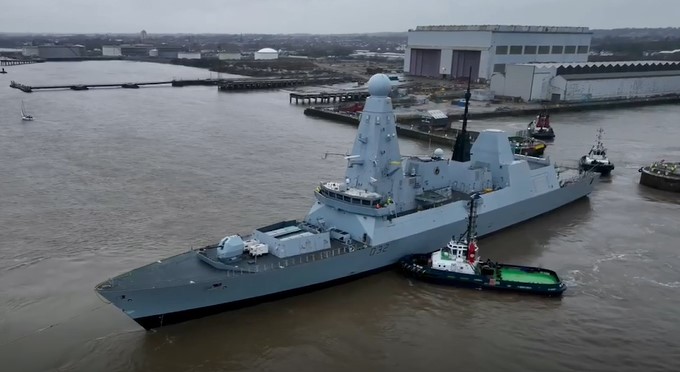UK’s Type 45 Destroyer HMS Daring “Stranded” in Shipyard for Seven Years for Repairs
According to a report by the UK Defense Journal, the Type 45 destroyer "HMS Daring" of the Royal Navy has spent more time in the shipyard undergoing repairs than it has in active service at sea.
(DEFENCE SECURITY ASIA) – The Type 45 destroyer “HMS Daring” of the British Royal Navy has caught the attention of military observers in the country as it has been docked for repair work for seven years, three months, and 19 days, or a total of 88 months, with the repairs still unfinished.
According to the UK Defense Journal, the warship has spent more time in the shipyard for repairs than it has in active service at sea.
HMS Daring was launched on February 1, 2006, and commissioned into the Royal Navy on July 23, 2009, beginning its official duties shortly thereafter.
During its service of six years, nine months, and 30 days, the warship participated in various missions, including deployment to the Persian Gulf in 2012 to provide maritime security and support anti-piracy operations.
It also took part in NATO exercises and provided humanitarian aid in the Philippines following Typhoon Haiyan in 2013.

However, due to critical propulsion system issues, HMS Daring has been “stranded” in the shipyard since April 2017 for repair work, which is being carried out at the Cammell Laird Shipyard in Birkenhead.
For seven years since April 2017, the Type 45 destroyer has remained in the shipyard undergoing repairs.
At long last, good news has emerged with the warship expected to rejoin the British Royal Navy fleet by the end of this year, marking the conclusion of one of the longest ship repair episodes in Royal Navy history.
HMS Daring had experienced serious problems with the design of the Northrop Grumman intercooler installed on its Rolls-Royce WR-21 gas turbines, which proved to be highly prone to failure, particularly when operating in tropical waters.
Due to these critical issues, the Type 45 destroyer HMS Daring had to undergo extensive maintenance and repairs to its propulsion system to restore it to optimal performance.
Another critical aspect of the repairs involved upgrading the ship’s power generation capabilities.

The original design of the warship did not account for the increased power demands of modern warships equipped with advanced electronic systems and modern weaponry.
Additionally, the repair work included efforts to upgrade the combat and electronic warfare systems of HMS Daring.
These upgrades are crucial to maintaining the operational effectiveness of the warship and ensuring it remains aligned with the advancements in naval technology worldwide.
The UK Defense Journal report also noted that logistical challenges played a significant role in the prolonged duration of the warship’s stay in the shipyard.
The COVID-19 pandemic further disrupted supply chains and the availability of workers, complicating the repair process.
Despite these challenges, the Type 45 destroyers remain among the most advanced warships in the world.

The Type 45 Daring-class destroyer, often referred to simply as “D” or “D-class” among observers, has been categorized as the most powerful destroyer ever built by the British Navy.
It was designed to replace the Type 42 Sheffield-class destroyers, which previously served the Royal Navy with distinction.
When the first Daring-class Type 45 destroyer was launched in 2006, senior British naval officials hailed it as the most powerful and capable anti-air warfare destroyer in the world.
Indeed, the Type 45 Daring-class destroyers were specifically designed to function as advanced air-defense destroyers, capable of countering threats from enemy aircraft and anti-ship/ballistic missiles.
The first of the Daring-class destroyers, HMS Daring, was launched in 2006 and commissioned into the Royal Navy in 2009.
Following HMS Daring, five additional Type 45 Daring-class destroyers were built, launched, and commissioned into service with the Royal Navy.

The second Daring-class destroyer, HMS Dauntless, was launched in 2007 and commissioned in 2010, followed by HMS Diamond (launched in 2007 and commissioned in 2011), HMS Dragon (launched in 2008 and commissioned in 2012), HMS Defender (launched in 2009 and commissioned in 2013), and HMS Duncan (launched in 2010 and commissioned in 2013).
Each of the six Type 45 Daring-class destroyers was constructed at a cost exceeding $1 billion (approximately RM5 billion) per ship.
In terms of technical specifications, each Daring-class destroyer displaces 8,400 tons and measures 152 meters in length.
With a crew of 191 (and a maximum capacity of 285 personnel), the Type 45 Daring-class destroyer can reach a maximum speed of 32 knots and has an operational range of up to 7,000 nautical miles at a cruising speed of 18 knots. — DSA



Comments are closed.